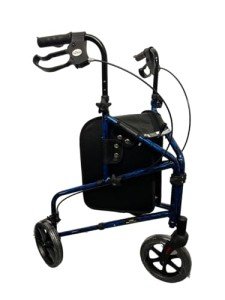
As the population ages, the demand for mobility aids like rollator walkers has actually risen. These walkers provide stability, support, and freedom of movement for individuals dealing with mobility issues, be they short-term or chronic. Understanding the types of rollator walkers offered, their benefits, features, and how to select the best one can substantially improve the quality of life for both the user and their caregivers.
A rollator walker is a mobility aid created to help people keep their self-reliance while walking. It includes a frame with four wheels, hand brakes, and a seat, making it ideal for users requiring extra assistance without the full limitations of standard walkers.
Rollator walkers come equipped with different features created to improve user experience. Here are some of the most common functions:
Rollator walkers use various benefits. They can considerably enhance mobility and safety for users. Here are some essential benefits:
Bonnlo All-Terrain Rollator Walker with Padded Seat walkers come in various designs and variations to satisfy specific needs. Here are a couple of common types:
| Type | Description |
|---|---|
| Requirement Rollator | Fundamental four-wheeled design designed for indoor and outdoor use. |
| Junior Rollator | A smaller version customized for much shorter people or kids. |
| Sturdy Rollator | Constructed to accommodate bigger body weights and offer extra stability. |
| Three-Wheel Rollator | Compact style perfect for navigating tight spaces. |
| Rollator with Seat | Features an integrated seat for resting during use. |
| Rollator with Storage | Includes detachable baskets or pouches for simple transportation of individual items. |
Selecting the right Rollator For Walking walker involves considering user requirements, choices, and physical requirements. Here are some elements to consider:

Appropriate maintenance can enhance the lifespan of a rollator walker. Here are some pointers for keeping it in great condition:
Q1: What is the average weight limitation for a rollator walker?A: Most basic rollator walkers support weights in between 250 to 300 pounds, while sturdy models can accommodate as much as 500 pounds. Q2: Can rollator walkers be used outdoors?A: Yes, numerous rollatorsare designed for Outdoor Walker use. Those with to 5 years on the frame and parts, guaranteeing sturdiness and user fulfillment. Q4: How do I correctly adjust a rollator walker?A: Adjust the handles to a height that permits the user to stand upright with elbows somewhat bent when holding the manages. Q5: Can after injuries or surgeries. Rollator walkers walkers, users can make informed choices that best match their lifestyle and needs. Whether recuperating from an injury or managing a long-lasting condition, a rollator walker can make a significant difference in the lifestyle, allowing individuals to regain their liberty and confidence while moving about the world.
bigger wheels and robust frames are especially matched for unequal surfaces. Q3: Do rollator walkers come with warranties?A: Many producers offer warranties varying from 1
I use a rollator walker for rehabilitation?A: Yes, rollators are frequently used in rehabilitation settings to improve walking confidence and mobility
are important tools that provide boosted mobility and self-reliance for lots of individuals. By understanding the types, benefits, and proper use of rollator